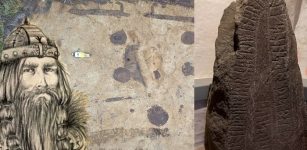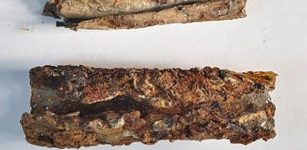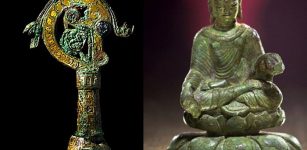Gold Treasures From The Land Of Ancient Colchian Culture In Georgia
A. Sutherland - AncientPages.com - The wealth of sophisticated, ancient goldsmithing of the Colchian Culture is enormous.
Necklace from Vani dated to 5th-4th century BC. Gold, weight: 88.968 g. The neclase is form of 56 crouching gazelles and 13 ribbed spacer beads. The animals were stamped in two halves and fused together. Ears and horns were added separately. Courtesy of the Georgian National Museum, Tbilisi.
The treasures of Colchis are associated with the famous myth, known in Greek mythology as the destination of the Argonauts' expedition to Colchis in their quest for the Golden Fleece.
The culture dates to the second half of the 3rd millennium BC and the first half of the 1st millennium BC.
Colchis, the ancient Georgian kingdom in Western Georgia, is legendary as a region abundant with gold. It has been known for centuries, and it is finally confirmed by the excavations of a series of rich ancient burials and other discoveries at the site of the town of Vani (now Imereti region).
Spectacular Gold Jewelry Of Colchis
Colchis was a highly developed culture, and so was their spectacular gold jewelry.
Necklace from Vani. Vani dated to 5th century BC. Gold, weight: 85.905 g.
The necklace is made up of thirty-one pendants in the form of charming turtles, with the eyes of the thirty small ones were done with glass inlay, and the large ones are made of gold. Their carapaces are decorated with granulation. (Found in Tomb 11) Image credit: Georgian National Museum, Tbilisi.
In the village of Sairkhe, located in western Georgia, 200 km from the Black Sea Coast, the excavations conducted between 1982 and 1990 on fifteen hills surrounding the village revealed burials and metallurgical workshops dated to the first millennium BC.
The unearthed tombs belonged to aristocratic families and contained wooden sarcophagi sealed with iron nails and protected by a massive quantity of stones.
Colchian pendants, riders and horses on wheeled platforms, Georgian National Museum. Image credit: Jonathan Cardy - CC BY-SA 3.0
In one of the coffins, archaeologists found temple rings, diadems and earrings, necklaces, bracelets, and finger rings, all made of gold. Other grave goods included less elaborate artifacts like Greek clay and silver vessels.
Here, we mention only some exquisite, ancient examples of Colchis stunning gold adornments. Left in legacy by skilled Colchian artisans, these items represent the sophisticated, ancient art of goldsmithing, and can be admired at the Vani Archaeological Museum and the State Museum of Georgia, Tbilisi.
In ancient times, Colchis was a colony of the Greek city of Miletus, which became one of the twelve Ionian city-states of Asia Minor to form the Ionian League.
Clip Headdress decoration (H-6.5 cm; H-6.5 cm), 4 th century BC from Vani, Western Georgia, The Georgian National Museum's collection
The Greek sagas connected the fabulous Colchis - the land of gold and magic - with the mythical land of Aja.
"The legend of the heroic quest of Argonauts is one of our civilization's oldest and most widely known myths, and the Golden Fleece is probably the most enigmatic phenomenon. For more than 2000 years already, an enormous volume of scientific research and pieces of art has been dedicated to this legend, with little to no truly reliable information found." 1
"…The topic has been and is still being studied by historians, archaeologists, and writers, but no one has yet studied it from a geological point of view. In the meantime, the geological argumentation may well prove crucial, as far as if the Argonauts' voyage has really happened and if the Golden Fleece is somehow linked to the gold mining technology, that might mean that the Argonauts have carried out one of the first geological expeditions in the history of our civilization…." 1
Necklace with Bird Pendants 400-350 B.C. Georgian National Museum. Photo by Amiran Kiladze. Image via georgiaabout.com)
Researchers matched the geological findings with the existing Greek and Roman written sources. They concluded that 'the voyage of Argonauts, a small team of Greek mythological heroes to the ancient kingdom of Colchis appears to have really happened.'
The expedition probably took place before the eruption of the Santorini volcano, between 1570 and 1580 BC, and it is unlikely they could carry out an expedition of this scale after the disaster.
Colchian gold diadem. Image credit: Jonathan Cardy - (with thanks to the, Georgian National Museum for allowing photography - CC BY-SA 3.0 DEED
'We assert that the primary purpose of this mission was to obtain gold and gold mining technology from those working along the river sands of the Kingdom of Colchis.
'As for the Golden Fleece phenomenon, according to our research, it is connected with the sheepskin (fleece) technique of gold recovering, which later on resulted in the formation of the romantic concept of the Golden Fleece that has existed in the civilized world ever since Homer's time….' 1
Written by – A. Sutherland AncientPages.com Senior Staff Writer
Copyright © AncientPages.com All rights reserved. This material may not be published, broadcast, rewritten or redistributed in whole or part without the express written permission of AncientPages.com
Expand for referencesReferences:
Gorji D. Colchis and the Golden Fleece
Avtandil Okrostsvaridze, The Argonauts: A Modern Investigation of the Mythical "Gold Sands
Natia Abramia, Georgia - Culture Smart!: The Essential Guide to Customs & Culture
More From Ancient Pages
-
 On This Day In History: Agatha Christie Known As ‘Queen Of Crime’ Died – On Jan 12, 1976
News | Jan 12, 2017
On This Day In History: Agatha Christie Known As ‘Queen Of Crime’ Died – On Jan 12, 1976
News | Jan 12, 2017 -
 Mystery Of The Large Ancient Boulders In Ireland And Britain – Possible Connection To The City Of Troy?
Featured Stories | Oct 17, 2023
Mystery Of The Large Ancient Boulders In Ireland And Britain – Possible Connection To The City Of Troy?
Featured Stories | Oct 17, 2023 -
 Mystery Of The Hunza People: Did They Really Live To 145 Years Of Age?
Civilizations | Jul 5, 2018
Mystery Of The Hunza People: Did They Really Live To 145 Years Of Age?
Civilizations | Jul 5, 2018 -
 On This Day In History: Myth Says Ancient Rome Was Founded By Romulus – On Apr 21, 753 BC
News | Apr 21, 2016
On This Day In History: Myth Says Ancient Rome Was Founded By Romulus – On Apr 21, 753 BC
News | Apr 21, 2016 -
 Njord: Norse God Of The Seas And Seafarers And His Unhappy Marriage To Skadi
Featured Stories | Jul 10, 2018
Njord: Norse God Of The Seas And Seafarers And His Unhappy Marriage To Skadi
Featured Stories | Jul 10, 2018 -
 Huge Viking Hall From Harald Bluetooth’s Time Discovered In North Jutland
Archaeology | Dec 22, 2022
Huge Viking Hall From Harald Bluetooth’s Time Discovered In North Jutland
Archaeology | Dec 22, 2022 -
 CT Scanning And 3D-Modelling Used To ‘Unfold’ Ancient Silver Plate Found In Jerash
Archaeology | Dec 26, 2015
CT Scanning And 3D-Modelling Used To ‘Unfold’ Ancient Silver Plate Found In Jerash
Archaeology | Dec 26, 2015 -
 The Helgö Treasure: Bronze Buddha Statue, Coptic Scoop And A Crozier Depicting Biblical Tale Of Jonah
Artifacts | Mar 10, 2023
The Helgö Treasure: Bronze Buddha Statue, Coptic Scoop And A Crozier Depicting Biblical Tale Of Jonah
Artifacts | Mar 10, 2023 -
 Olive Trees Were First Domesticated 7,000 Years Ago In The Jordan Valley
Archaeology | Jun 17, 2022
Olive Trees Were First Domesticated 7,000 Years Ago In The Jordan Valley
Archaeology | Jun 17, 2022 -
 Highly Advanced Robots In Ancient China
Ancient Technology | Aug 7, 2015
Highly Advanced Robots In Ancient China
Ancient Technology | Aug 7, 2015 -
 Controversial Artifacts No One Wants To Examine Thoroughly: Is There Something We Are Afraid Of Discovering?
Ancient Technology | May 22, 2019
Controversial Artifacts No One Wants To Examine Thoroughly: Is There Something We Are Afraid Of Discovering?
Ancient Technology | May 22, 2019 -
 Countess Loretta Of Sponheim Kidnapped Archbishop Of Trier And Got Away With It
Featured Stories | Sep 26, 2018
Countess Loretta Of Sponheim Kidnapped Archbishop Of Trier And Got Away With It
Featured Stories | Sep 26, 2018 -
 Roman-Era Female Statue Dated Back To 1,800 Years Ago Unearthed In Anemurium, Türkiye
Archaeology | Nov 14, 2023
Roman-Era Female Statue Dated Back To 1,800 Years Ago Unearthed In Anemurium, Türkiye
Archaeology | Nov 14, 2023 -
 Harappan Civilization Built Massive Protection Walls Against Tsunami 5,000 Years Ago
Archaeology | Jan 10, 2017
Harappan Civilization Built Massive Protection Walls Against Tsunami 5,000 Years Ago
Archaeology | Jan 10, 2017 -
 Civita di Bagnoregio – Magnificent 2,500-Year-Old Etruscan City In The Sky Is Struggling To Survive
Featured Stories | Jun 23, 2021
Civita di Bagnoregio – Magnificent 2,500-Year-Old Etruscan City In The Sky Is Struggling To Survive
Featured Stories | Jun 23, 2021 -
 Bronze Age ‘Washingborough Boat’ Will Reveal Boat Building Techniques Of Ancient People
Archaeology | May 11, 2017
Bronze Age ‘Washingborough Boat’ Will Reveal Boat Building Techniques Of Ancient People
Archaeology | May 11, 2017 -
 Lunar Society: Great Scientists Of The 18th Century Who Changed The World
Featured Stories | Jul 13, 2018
Lunar Society: Great Scientists Of The 18th Century Who Changed The World
Featured Stories | Jul 13, 2018 -
 King Ferdinand’s Secret Code Deciphered After 500 Years
Archaeology | Feb 14, 2018
King Ferdinand’s Secret Code Deciphered After 500 Years
Archaeology | Feb 14, 2018 -
 Controversial Hollow Earth Theory – Questions And Answers – Part 3
Featured Stories | Jun 28, 2019
Controversial Hollow Earth Theory – Questions And Answers – Part 3
Featured Stories | Jun 28, 2019 -
 Ancient Village Of Monsanto, Miraculously Balanced Giant Boulders And Knights Templar Connection
Civilizations | Dec 20, 2018
Ancient Village Of Monsanto, Miraculously Balanced Giant Boulders And Knights Templar Connection
Civilizations | Dec 20, 2018






